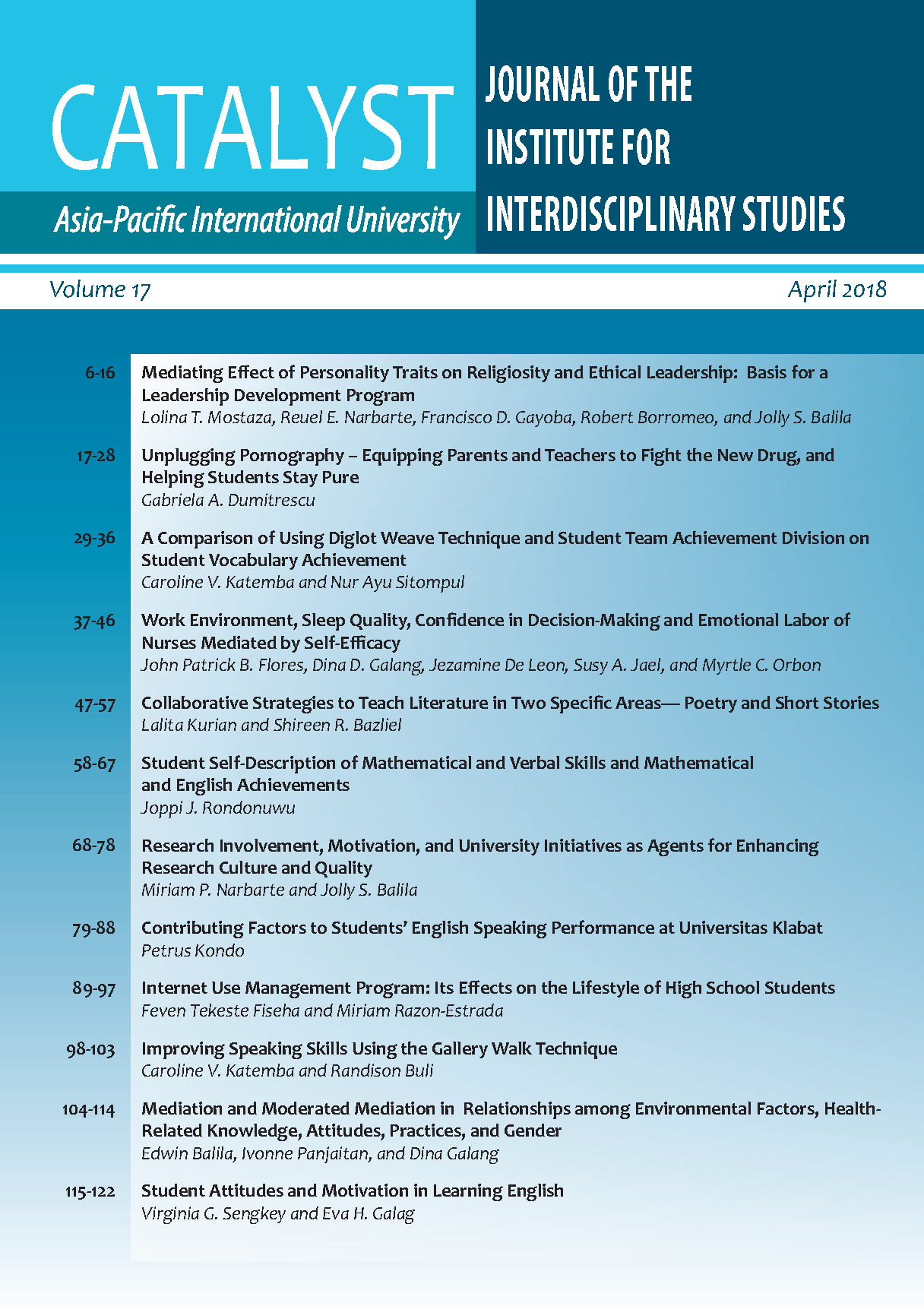Research Involvement, Motivation, and University Initiatives as Agents for Enhancing Research Culture and Quality
Main Article Content
Abstract
This paper determined the research involvement and motivation of university faculty in research and research-related activities. It discusses the university research initiatives as agents in enhancing and promoting research culture and quality. Data from the university records and survey questionnaires were used to determine the research involvement of faculty. University research initiatives and other information needed in this study were generated from the university accreditation documents and from research and faculty manuals. There is increasing faculty research involvement for the last five years. Fifty percent were sampled from 179 faculty members to determine the faculty involvement in research-related activities and their motivation of involvement. The top five research-related activities involvement are: sat as a panel member in an oral defense; supervised undergraduate thesis; mentored undergraduate; enriched self on research methodologies, statistics, and research writing; and presented a paper in the national and international conferences. On the other hand, the factors that motivate University faculty to be involved in research are: utilization of research; personal satisfaction; build/expand network; research capability building programs of the University; and support of the administration. Research initiatives were created and implemented by the university and spearheaded by the University Research Center to enhance research culture and quality. The research initiatives were based on the goals articulated by National Higher Education Research Agenda (NHERA-2).
Article Details

This work is licensed under a Creative Commons Attribution-NonCommercial-NoDerivatives 4.0 International License.
Copyright: Asia-Pacific International University reserve exclusive rights to publish, reproduce and distribute the manuscript and all contents therein.
References
Bland, C., Center, B., Finstad, D., Risbey, K., & Staples, J. (2005). A theoretical, practical, predictive model of faculty and department research productivity. Academic Medicine, 80(3), 225–237.
British Council. (2015). Opportunities and challenges in the internationalisation of the Philippine higher education sector (2015). British Council and Foreign Commonwealth Office, p. 26. Retrieved from https://www.britishcouncil.ph/sites/default/files/opportunities_and_ challenges_in_the internation alisation_of_philippine_higher_education_sector.pdf.
CHED Memorandum Order (CMO) No. 01 Series of 2000 on
“Policies and Guidelines in the Implementation of International Linkages and Twinning Programs.” DAP Bldg., San Miguel Avenue, Ortigas Center, Pasig City, pp. 1-7. Retrieved from ched.gov.ph/wp-content/ uploads/2013/07/ CMO-01-S.-2000.
Commission on Higher Education [CHED]. (2009). National higher education research agenda-2: NHERA 2: 2009-2018. Manila, Philippines: CHED.
Dacles, D., Valtoribio, D., Del Rosario, F., Matias, C. & Saludarez, M. (2016). Cultivating research culture: An analysis of contributing factors, the institution’s research initiatives, and collaboration among the HEI’s trifocal functions. American Journal of Educational Research, 4(6), 439-449. Retrived from doi: 10.12691/education-4-6-2.
Keeves, J. (1999). Overview of issues in educational research. In J.P. Keeves, & G. Lakomski (Eds.) Issues in Educational Research (pp. 3-13). The Netherlands: Pergamon.
Ma, Y., & Runyon, L. (2004). Academic synergy in the age of technology—A new instructional paradigm. Journal of Education for Business, 79(6), 367–371.
Munir, N., & Bolderston, A. (2009). Perceptions and attitudes toward conducting research: A nuclear medicine student perspective. Journal of Medical Imaging and Radiation Science, 40, 183– 189.
Paterson, G., Rachfall, T., & Colleen, R. (2013). Building a culture of research: Using undergraduate research to advance the TR profession, build research capacity, and foster collaborative relationships. The Recreation Journal, 47, 259–275.
Rosaroso, R., Dakay, I., & Sarmiento, R. (2015). Selected Philippine higher education institutions’ perspectives on internationalization of education: Initiatives and guidelines. Asia Pacific Journal of Education, Arts and Sciences, 2(4), 41. Retrieved from www.apjeas.apjmr.com.
Salazar-Clemeña, R., & Almonte-Acosta, S. (2007). Developing research culture in Philippine higher education institutions: Perspectives of university faculty. Retrieved from http://portal.unesco.org/education/en/files/54062/11870006385Rose_Marie_Clemena.pdf/R ose_ Marie_Clemena.pdf.
Toews, M., & Yazedjian, A. (2007). The three-ring circus of academia: How to become the ringmaster. Innovative Higher Education, 32(2), 113–122.
Wa-Mbaleka, S. (2015). Factors leading to limited faculty publications in Philippine higher education institutions. Adventist International Institute of Advanced Studies International Forum Journal, 18(2), 121-141.
Zain, S., Ab-Rahman, M., Ihsan, A., Zahrim, A., Nor, M., Zain, M., Hipni, A., Ramli, N., and Ghopa, W. (2011). Motivation for research and publication: Experience as a Researcher and an Academic. Procedia Social and Behavioral Sciences, 18, 213–219. Retrieved from doi:10.1016/j.sbspro.2011.05.030.
Zhang, X. (2014). Factors that motivate academic staff to conduct research and influence research productivity in Chinese Project 211 Universities. Unpublished Manuscript. University of Canberra, Australian Capital Territory, Australia. Retrieved from http://www.canberra. edu.au/researchrepository/file/0814ee30-680b-401e-b059-3905b0b686cc/1/full_text.pdf.


